[Posted 3 Oct. 2008, 5.23am, by Stephen Pirie]
Are there some rules by which we can clarify our understanding of life? Are there key principles that can be used for practical results, to yield greater creativity, understanding, ease, peace-of-mind?
Clearly, a key principle must exist .. some connecting mechanism or principle has to be operating at a root level of life. Furthermore, whatever that principle, it has to accommodate the theories and proofs of science, particularly science's most successful physical theory in history (quantum mechanics).
How might we recognise this principle? What should we look for? Can we use it in any area of life, to more deeply understand any experience?
Introducing the Pairadox Rule -- a useful tool by which to assess 'truth' and by which to advance understanding, insight, creativity and effectiveness.
Q. Is Darwinian Evolution correct, or "Intelligent Design"?
Q. Can I achieve enlightenment?
Q. Can I transcend my ego and achieve perfection?
Q. Will brain research reveal why people shop-lift, or are violent and anti-social?
Q. Will scientific research find a cure for cancer, AIDs or diseases in general?
Q. What about all that missing "Dark Matter" in the universe?
Q. What's the 'secret' to sex, gender and relationships?
Q. What's needed to be highly creative and innovative?
Q. To what extent does profitability rely on creativity and innovation?
Q. How do we see through and beyond the latest management fads?
Q. Is there a "glass ceiling" for women seeking executive roles in large organisations?
The Paradox Rule* (introductory technical framework)
The Paradox Rule1 (or more technically, The Pairadox Rule) begins by embracing our personal experiences of individuality and conscious awareness. Unlike many new-age schools of thought, it does not exclude or 'make wrong' ego, or individuality.
It then includes that experience (of ego) within a broader context of some greater whole (community).
Fig. (see right) displays this relationship.
Then we include some key principles from the "most successful physical theory in history"2 (quantum physics).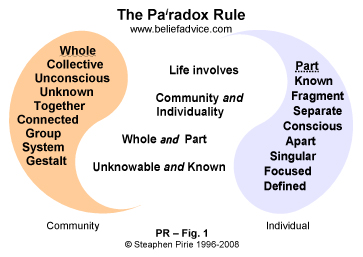
Specifically, we embrace the phenomenon of nonlocality - "the most profound discovery of science."3 Basically, everything is instantly interconnected. How things interconnect and influence each other gives rise to various 'lattice-works' (e.g. fractals and other mathematical frameworks by which nature and the physical system unfolds into life and physicality (resp.)).
Next, we work with the experimental evidence that all matter and energy behaves as both waves and particles. The particle nature is the physical material we're familiar with in everyday life ... the stuff that comprises computers, cars and cats.
As for the wave nature, the (late) physicist Sir Lawrence Bragg explained: "everything that has already happened is particles, everything in the future is waves"4 and 'The advancing sieve of time coagulates waves into particles at the moment “now."'5
The wave-nature is indicative of the possibilities washing our way. As physicists have come to appreciate, the peak of the particle's wave indicates the most probable place it will "pop" into reality.
Putting all that together, and since everything is interconnected, we end up with Fig. 2.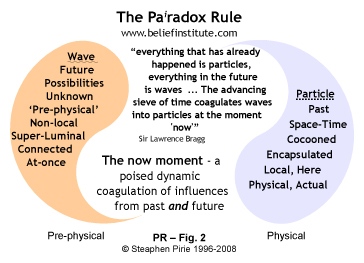
Since we're made of 'quantum stuff' that behaves as both waves (future-possibilities) and particles (past-actuality), we can expect that this wave-particle duality says something about why we behave the way we do.
The description of waves and particles by physicist Nick Herbert (Quantum Reality) is that "As a particle, it must be localized in space, cannot be split apart, and retains its identity in collisions with other particles. As a wave, it spreads over vast regions of space, is divisible in an infinity of ways, and merges completely with other waves it happens to meet."6
If we keep in mind that the right side (right-wing) of the tables cannot be perfectly independent of the left-wing (as that would require communities to exist without individuals; or breaking the wave-particle duality), we can appreciate that people lean towards adopting wave-nature (socialism, collectivism, selflessness) or particle-nature (individualism, capitalism, status, selfishness).
By working through some of the implications of the above (using robust analysis and consistency), we arrive at Fig. 3.
Some of the easily-recognised implications of the Pairadox Rule is that 'masculinity' or 'femininity' is not driven entirely by the physical (genes, hormones), but also by non-physical influences of emotional intent. The cause for behaviour won't be entirely reduced to anything physical.
Likewise intelligence: The reasons we think and behave the way we do won't be reduced entirely to what's occurring in the material that comprises our brains. Nor will the cause for behaviour (or misbehaviour) be reduced to the 'system' (culture, collective) in which we presently live (as follows from analysis and application of the Pairadox Rule).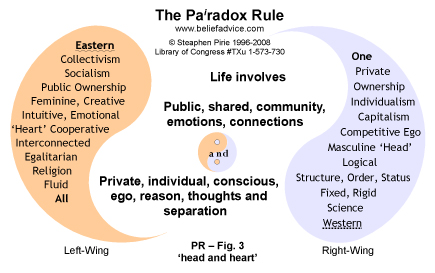
As physicist David Bohm explained: "The actual operation of intelligence is beyond the possibility of being determined or conditioned by factors that can be included in any knowable law ... Intelligence is thus not deducible or explainable on the basis of any branch of knowledge (e.g. physics or biology). Its origin is deeper and more inward than any knowable order that could describe it."7
In view of the above, we may remain confident that The Pairadox Rule is always applicable and can be used to "decode" any experience, or any fact, in any field of human study, such as:
Application
Q. Is Darwinian Evolution correct, or "Intelligent Design"?
Both are "wrong" (within the context of the general understanding, analysis and discussions). Within a broader, deeper context (as covered by the Pairadox Rule) both are "right" in that the system we experience is newly forming and being formed by intelligent interaction with the physical environment.
... read more
Q. Can I achieve enlightenment?
If by enlightenment we mean some perfect state of beingness in which all is known, no. According to the Pairadox Rule (the ubiquitous pairing of known with unknowable, of finite with infinite, of actual and possible), requires we'll continue having individual conscious choice, and the freedom and responsibility that goes with choice (see Fig. 1, below) – even after we're dead. For reasons explained in other articles at this site, our awareness cannot be entirely reduced to our physical brains that are localised in time and space, but must be supported by deeper, interconnecting nonlocal fields of intent. See the section below.
Q. Can I transcend my ego and achieve perfection?
If by ego we mean individual awareness, 'transcending the ego' would require communities (collectives) without individuals. In short, the answer to the question is 'no.'
In any case, assume we achieved some perfect state of oneness without ego. Who or what is then 'coagulating' waves of possibility into experienced actuality (See Figure 1 below)? Individual awareness (ego) by any other name still smiles like one.
The reason for the belief that we can transcend or 'give up' the ego is rooted in the either-or thinking that is characteristic of our era.
As explained, the Key Principles require that life is both conscious ego, and unconscious connectedness, at-once, together.
Q. Will brain research reveal why people shop-lift, or do other not-so-nice things?
No. See the foregoing technical section about intelligence not able to be reduced to any knowable order (biological or physical). See also "Jill Bolte-Taylor's TED presentation"
Q. Will scientific research find a cure for cancer, AIDs or diseases in general?
If by "cure" we mean finding the root causes for physical ailments and mishaps, no.
Science has provided, and will continue to provide practical, useful and valuable insights into the physical system, but physical effects (facts) cannot be reduced entirely to physical (scientific) causes -- as required by the Pairadox Rule.
As has been understood in the field of physics for around 80 years, a particle's wave-nature shows its 'pre-physical' field of possibility, or as French physicists have described the wave nature, its "presence density."
In our normal lives, many understand this "presence density" as a gut-feeling of impending events; of there being "something in the air."
The Pairadox Rule is a robust tool to understand life's many and varied phenomena because it is grounded in "the most successful physical theory in history."1 For the Pairadox Rule to not apply or not be relevant to some situation would require breaking Heisenberg's Uncertainty Principle, as well as stopping (left-wing) waves of possibility coagulating into experienced (right-winged) actuality.8
In other words, we'd need to break the process in Figure 1.
And if we were to wish that some superior agency (e.g. God) were to entirely make decisions for us, what fun would there be in that?
Happiness, according to Nobel Laureate William Butler Yeats, involves growth -- learning how to handle more energy and responsibility, not less.
According to Yeats, "Happiness is neither virtue nor pleasure nor this thing nor that but simply growth. We are happy when we are growing."
Growing means, within the context of Figure 1, expanding the range of possibility (commensurate with increased energy and momentum) and 'coagulating' the possibilities into meaningful and desired systems of order (structures, outcomes, buildings, bodies, societies etc).
... to be continued
Q. Isn't the Pairadox Rule a dogmatic belief as well?
The Pairadox Rule simply says that whatever exists, be it in the future, or in whichever dimension, is not entirely or "perfectly" disconnected from our everyday conscious experiences. In other words, the Pairadox Rule embraces infinite inclusiveness and connectedness.
Exceptions are based on a belief in separateness, and require imagined disconnects from "oneness" (infinite inclusiveness). Exceptions are therefore not fundamentally valid or meaningful (other than as a means to cocoon individuality, experience and awareness).
Q. Are Buddhist ideas of reincarnation correct?
If by that question we mean, "will bad karma mean I come back as a slug, or snail or some such?" - no. Consciousness (like the universe) is continually cycling and expanding, involving greater acceptance and responsibility of energy.
However, by applying the Pairadox Rule we can appreciate that some Buddhist beliefs are closer to reality than many other religions (or sciences).
Q. What about all that missing "Dark Matter" in the universe?
The Pairadox Rule accounts for (explains) Dark Matter and Energy -- it is simply the 'presence density' of alternate possible systems affecting our system. The Pairadox Rule also provides the framework to explain why nature and the distribution of galaxies9 is inherently fractal. And how to integrate quantum theory with relativity (by applying principles that underpin micro and macro, wave and particle).
Q. What does the Pairadox Rule reveal about sex, gender and relationships?
The Pairadox Rule is based on the fundamental wave-particle behaviour of matter and energy. Men, male animals and various classes of matter and energy (e.g. fermions)10 tend towards the masculine qualities of individual-particle nature (hence the traditionally work-competitive, solitary/ egoic/ scientific/ technological/ physical bias of men). Women, female animals and other classes of matter-energy (e.g. bosons)8 tend towards the feminine qualities of the collective-wave nature (hence the traditionally home-procreative, caring, collective, communal, communicative bias of women etc).
However, the Pairadox Rule requires that no man or woman, particle or wave, can be 'entirely' masculine-particle or feminine-wave. That is to say, men can be (and are, inherently) as feminine as women, and vice versa. The often-cited references to Darwinian "survival of the fittest" impetuses are relatively superficial causes for behaviour. As explained and illustrated in the "The Evolution of the Human Psyche" article, we are presently in an era of peak disconnect between feminine-wave and masculine-particle - meaning, we've lost touch with our intuitive, creative potentials. Physical survival therefore receives undue bias in scientific research and theories - hence the belief in Darwinian 'survival of the fittest' theories (which are "naturally selected" by scientists who have a masculine-particle bias).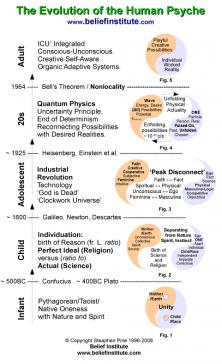
The peak-disconnect of the human race explains the scepticism of atheists and sceptics concerning 'spiritual' or meta-physical dimensions, and the increasing fundamentalism in religion and science.
... to be continued
Q. What's needed to be highly creative and innovative?
To be highly creative, in any field, requires some key elements and characteristics.
From considerable research, we now know that highly creative people in any profession or the arts, invest many thousands of hours practicing and improving their craft.
As Nobel Laureate Francis Crick explained,
more soon...
Q. To what extent does profitability rely on creativity and innovation?
As a result of deeply entrenched Darwinian beliefs (see previous question and The Evolution of the Human Psyche), most business folk (and sales people) focus on being more competitive (increasing market share).
However, current trends indicate that the future of business, in a more networked, interdependent world, will be more about working “smarter” (more creative, original, innovative) than working “harder” (more competitive) - hence the understanding of the growing need for creativity and innovation.
Research confirms that those companies that lead12 in terms of innovation (e.g. Canon of Japan) have a corporate culture that is creative and innovative from the top down.
In practical terms, enhancing creativity and innovation within an organisation requires 'going beyond convential beliefs' -- opening ourselves to creative (feminine) abilities, while keeping a focus on deadlines, results and required outcomes.
... to be continued
Q. How do we see through and beyond the latest management fads?
We can see beyond dogma, superstition and fads by simply applying timeless principles – Key Principles of Life, for Life.
Q. Is there a "glass ceiling" for women seeking executive roles in large organisations?
When business commentators decry the lack of female CEOs and senior executives in corporate organisations, they are failing to note that the world we experience is the result of deeper rhythms and impetuses being applied for practical (and profitable) outcomes.
Is there a glass ceiling for women seeking executive roles in large organisations? No more than there is a "glass curtain" for men seeking to be house-husbands, or the primary care-givers in society.
The Pairadox Rule affirms the world we experience is a self-organising and self-serving system that we have consciously helped create -- "we're all in this together." While there is generally an inertia with belief systems ("social gravity") that can dissuade women from being 'masculine' (executives), and men from being 'feminine' (care-givers), the society and world 'out there' is our deep-seated personal beliefs and choices writ large.
... to be continued
Notes:
* The Pairadox Rule expresses and works the "inseparable-duality" or "pairing" of infinite and finite, of conscious and unconscious, of connected and disconnected, of wave and particle etc.
- 1. for the benefit of search engines, it is written The Paradox Rule on this page
- 2. Paul Davies, J.R. Brown, The Ghost in the Atom, Cambridge University Press, Cambridge 1995, page 84. {quoting Dr David Deutsch, Oxford University}
- 3. Dr Henry Stapp, "Bell's Theorem and World Process" Nuovo Cimento, 29B, 270-276 (1975).
- 4. Ronald W. Clark, Einstein, The Life and Times, Hodder and Stoughton London 1979, page 331.
- 5. Clarke, page 331
- 6. Nick Herbert, Quantum Reality: Beyond the New Physics, Anchor Press/Doubleday, New York, 1985, page 64.
- 7. David Bohm, Wholeness and the Implicate Order, Routledge, London 1995, page 41.
- 8. It would be necessary to break Gödel's Incompleteness Theorem in mathematics, along with Gregory Chaitin's Randomness Theorem, Turing's Uncomputability Problem, and in general show how our universe is not "overwhelmingly nonlocal." (See nonlocality)
- 9. "... studies we have done show that the distribution of matter is fractal, just like a tree or a cloud. Our tests show that the Universe never becomes homogeneous in the available galaxy samples. It remains hierarchically clustered. It remains fractal." Francesco Sylos Labini, University of Geneva {Source: New Scientist, August 21, 1999}
- 10. In the quantum realm, all observed elementary particles are either 'masculine' (fermions) or 'feminine' (bosons). Fermions are 'hard' particles that could be described as being the epitome of individuality - they uniquely occupy/create their own individual space (no two fermions can occupy the same quantum state & space as per the Pauli Exclusion Principle), whereas bosons can and do 'merge' to occupy the same quantum state (of "oneness").
- 11. Mehrdad Baghai & Angus Dawson, The Growth Challenge, AFR Boss Magazine, Feb. 08 Edition, John Fairfax Publications Pty Ltd, Sydney, page 26.
- 12. Canon was chosen number one in innovative success in 2004 and 2005 by the Japanese newspaper Nihon Keizan Shinbun (among a list of the top 500 companies every year).
- 13. Fangqi Xu, Tudor Rickards (2007). Creative Management: A Predicted Development from Research into Creativity and Management, Creativity and Innovation Management Journal 16 (3), 216–228. doi:10.1111/j.1467-8691.2007.00445.x

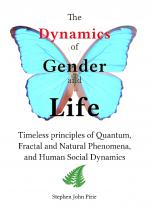 "The Dynamics of Gender and Life" ebook is now available at
"The Dynamics of Gender and Life" ebook is now available at